You will need
- - measurement data;
- calculator.
Instruction
1
Before you can calculate absolute uncertainty, take for initial data a few postulates. Eliminate gross errors. Accept that the necessary amendments have already been calculated and included in the result. The amendment may be, for example, the transfer starting point of measurement.
2
Take as a starting position that is known and taken into account random error. This implies that they are less systematic, i.e., absolute and relative, are specific to this device.
3
Random errors affect the result, even high-precision measurements. Therefore, any result will be more or less close to absolute, but there will always be differences. Determine this interval. It can be expressed by the formula (Hism - HH)≤Chism ≤ (Hism+HH).
4
Determine the amount that approximated to the true value. In real measurements, the arithmetic mean, which can be found using the formula shown in the figure. Take the result for the true value. In many cases, as accurate a reading is taken of the reference device.
5
Knowing the true value of the measurement, you can find the absolute error, which should be considered in all subsequent measurements. Find the value of X1 – specific data measurement. Determine the difference between the HH, subtracting a larger number from a smaller. When error determination takes into account only the module of this difference.
